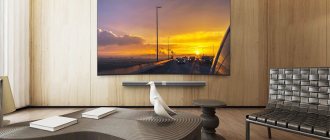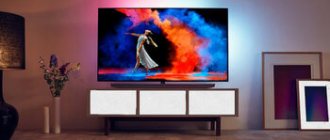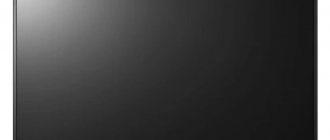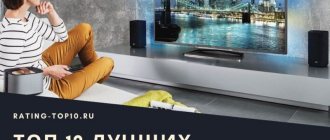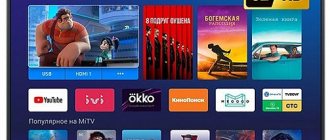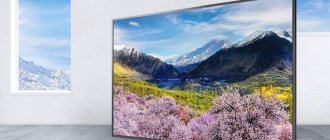The best Qled Samsung models
Samsung The Serif QE55LS01TAU 55″
Price: from 83,200 rubles.
Pros:
- spectacular design;
- high-quality images from different angles;
- fast-acting Smart;
- reliable assembly.
Minuses:
- not very developed sound;
- high price.
55-inch QLED TV for placement in the bedroom or living room. In addition to high resolution and a high-quality matrix, it also boasts a refresh rate of 200 Hz. This indicator is enough to display the most dynamic scenes without any distortion.
There are four 10 W speakers installed inside. Control is carried out using a universal remote control or voice commands.
Samsung The Frame QE65LS03TAU 65″
Price: from 129,900 rubles.
Pros:
- picture quality;
- good built-in sound;
- functionality;
- fast work;
- All connections in one place with One Connect.
Minuses:
- The remote control gets scratched quickly;
- overcharge.
Quite an expensive 65-inch TV that fits perfectly into any interior. Can serve as a painting on the wall. Thanks to the special One Connect box, all connections are made in one place without an abundance of unnecessary wires along the walls.
The device supports the Samsung SmartThings ecosystem, through which it is possible to combine several devices with each other.
Samsung QE58Q67TAU 58″
Price: from 74,900 rubles.
Pros:
- thin frames around the edges;
- turns on quickly;
- many applications to install;
- Airplay support.
Minuses:
- Navigation in the menu may be slow;
- not very high quality sound.
4K TV with support for HDR10+ technologies and a refresh rate of 100 Hz. Two built-in speakers with a power of 10 W each are responsible for the sound. The volume reserve is enough even for large rooms, but the sound clearly lacks depth and sophistication.
The model comes with a stand, but if necessary, can be placed on the wall using a bracket.
Samsung The Serif QE49LS01TBU 49″
Price: from 65,400 rubles.
Pros:
- beautiful appearance;
- high-quality image;
- convenient control panel;
- good assembly;
- reliable stand.
Minuses:
- inconvenient location of some ports;
- not intended for wall mounting.
LCD TV with rich sound from four speakers with a total power of 40 W. There is a Dolby Digital decoder, as well as an automatic volume equalization function.
All necessary ports are provided for convenient connection of third-party equipment, as well as maintaining a stable connection to wireless networks.
Samsung QE55Q80TAU 55″
Price: from 87,700 rubles.
Pros:
- deep black color;
- uniform illumination;
- brightness reserve;
- fast and intuitive interface;
- good sound.
Minuses:
- difficulty in adjusting the image;
- Sometimes there are delays.
The device has a VA matrix and high-quality LED backlighting, which guarantees uniform display and the necessary brightness margin for comfortable viewing even on a sunny day.
There are 6 speakers inside with a total power of 60 W. There is even a small subwoofer that produces good low frequencies. The model can be mounted on a stand or hung on a wall using a standard VESA bracket.
Budget Samsung TVs
Samsung UE32T5300AU 32″
Price: from 18,300 rubles.
Pros:
- availability;
- convenient control;
- functionality;
- high quality picture.
Minuses:
- inconvenient control panel;
- fragile stand.
High-quality, and at the same time relatively inexpensive Samsung 7 series TV. With a diagonal of 32 inches, it has 1080p Full HD resolution, guaranteeing clear images. The built-in Smart TV runs on the Tizen operating system.
There are two 5 W speakers, which are enough power for a small room or kitchen. The device weighs 4 kg and can be installed on a special stand or hung on the wall.
Samsung UE32T4510AU 32″
Price: from 18,300 rubles.
Pros:
- stylish design with thin frames around the edges;
- ease;
- large viewing angles;
- compact control panel.
Minuses:
- flat sound;
- there are delays.
Budget TV with small dimensions and average characteristics. It has 720p HD resolution and also supports HDR. There is a light sensor to adjust the screen brightness automatically.
Two speakers with a total power of 10 W produce average sound at a volume sufficient for a kitchen or small room. There is Micro Dimming Pro and TV Key app support.
Samsung UE43T5202AU 43″
Price: from 23,200 rubles.
Pros:
- relatively low cost;
- high-quality assembly;
- simple initial setup;
- fast and clear menu;
- protection from children;
- volume reserve.
Cons: the case is easily soiled.
Model with TV Key support and a 43-inch screen with Full HD resolution. It has a refresh rate of 50 Hz, which is enough for standard content. However, when playing fast-paced scenes or playing video games, various distortions may occur.
The Tizen operating system makes it easy to install applications from the official store, thereby significantly expanding the capabilities of the TV.
Samsung UE43RU7100U 42.5″
Price: from 30,000 rubles.
Pros:
- laconic design;
- support for wireless interfaces;
- bright and rich colors;
- automatic setting of the desired mode.
Cons: uncomfortable legs.
An easy-to-use TV that is suitable for both standard viewing of TV channels and for using Internet TV or playing video games. With a diagonal of 42.5 inches, the model has full 4K UHD resolution, which is rare in this price category.
The 100Hz refresh rate ensures image integrity is maintained even when playing very dynamic scenes.
Samsung 43TU7002U
Price: from 33,000 rubles.
Pros:
- thin frames around the edges;
- a high resolution;
- high-quality VA matrix with a refresh rate of 100 Hz;
- volume reserve.
Cons: not very high quality sound.
A multifunctional TV based on the Crystal 4K processor, which guarantees fast work with all interface elements. The device easily finds the desired content and runs it in high quality without any distortion.
The sound is provided by two 10 W speakers, so the volume is enough even for a large room. The model supports all popular formats, so there should be no problems with playing files from external media.
Specifications
All Samsung TVs, presented in 6 series, are almost technically identical. They differ mainly in design and minor technical parameters. Series 9 is the latest, it is the most advanced and expensive. And the earliest, the 4th series, has the simplest parameters and a budget price.
Here are the main technical characteristics that you should pay attention to in order to narrow your search:
- Screen resolution: Full HD (1920x1080), Ultra HD (3840x2160), SUHD (3840x2160).
- Screen diagonal – from 19″ to 88″.
- Display type: curved or flat.
- Storyboard for conveying smooth movement during dynamic scenes: 200 Hz, 1000 Hz, 1200 Hz.
- Image quality - 14 different technologies.
- Possibility of sending commands to the device: integrated camera, voice or gesture commands, determination of facial biometric parameters.
In the latest episodes, such characteristics are presented in the best possible way.
Samsung 9 series
TV receivers in this series are represented by flat and curved LED devices with Ultra HD and SUHD. They are distinguished by:
- an amazing degree of completeness in reproducing small details and sharpness of contours;
- innovative techniques that make images better;
- modernization of individual functions.
Distinctive characteristics of the Samsung 9 series TV:
- UHD - the screen image is striking in its realism.
- Motion Rate - eliminated the previously existing blur in scenes with increased mobility.
- Ultra Clear Panel - almost completely solved the problem of glare on the screen.
- The display has a special org coating - this guarantees a greater degree of reproduction of small details.
- The ability to immediately convert 2D format to 3D.
- Built-in webcam.
- Modified remote control.
- The ability to control the device using voice or gestures.
- Samsung Evolution Kit simplifies the connection of various devices and media to the device, since all electrical connectors are neatly placed separately on the set-top box.
- Smart TV responds almost instantly.
Samsung 8 series
The special features of this model line of television devices are their ultra-thin design, which can erase edges.
The new design makes the device so sophisticated that it can decorate even the most sophisticated interior. Distinctive features:
- Remastering Engine - provides realistic images by conveying the smallest details of moving scenes.
- The innovative development of Nano Crystal allows you to expand the color range and increase the shade palette by 4 times.
- The TIZEN operating system for Smart TV allows you to place a large number of applications in the menu.
Samsung 5 series
This series is ideal for those who prefer good quality things, without “extra” innovative implementations.
Such TVs are budget, but at the same time have a basic set of functions and options. Models in this series are perfect for people who treat TVs as TVs and don't expect much from them. Such devices lack Smart TV and 3D functions, as well as advanced new-fangled technologies. But if their presence is not important for a person, then why pay extra money for something you won’t use. And at the same time, if compared with the 4th series, there are still improvements in this one - Full HD (1920x1080 pixels).
Despite the minimalism, even the first models of television receivers from this manufacturer cannot be called primitive. The main technical characteristics of Samsung TVs clearly indicate that they have full functionality and are easy to use.
Samsung's Top 55
Samsung UE55TU7140U
Price: from 46,900 rubles.
Pros:
- excellent image;
- slim design;
- subtle frames around the edges;
- performance.
Minuses:
- there may not be enough ports to connect external equipment;
- inconvenient control panel.
Another classic model on the Tizen operating system with the ability to install any applications of interest. The performance and RAM are enough to run the most complex programs and open media files in high quality.
Together with the complete stand, the device weighs about 14.2 kg, but if necessary, it can be mounted on the wall using a bracket.
Samsung QE55Q80TAU
Price: from 87,700 rubles.
Pros:
- deep black color;
- brightness reserve for comfortable viewing even in bright sun;
- convenient branded control panel;
- fast interface.
Minuses:
- Voice control does not always work;
- poorly designed sound.
55-inch QLED TV with VA matrix and the ability to operate at frequencies up to 200 Hz. This indicator ensures maximum smoothness of the picture and the complete absence of any distortion.
A viewing angle of 178 degrees ensures comfortable viewing from anywhere in the room. The device supports Amazon Alexa and Google Assistant voice assistants.
Samsung UE55TU8570U
Price: from 52,900 rubles.
Pros:
- deep black color;
- natural shades;
- reliable assembly;
- durable metal remote control;
- good sound.
Cons: awkward to type.
This TV has a VA matrix with high-quality LED backlighting, which ensures uniform illumination of the surface and the absence of any glare.
The 120Hz refresh rate allows you to view dynamic scenes without distortion, which will be very useful for video game fans. If desired, you can record content of interest from the TV to a USB drive.
Samsung The Frame QE55LS03TAU
Price: from 109,900 rubles.
Pros:
- attractive appearance;
- easy to hang on the wall;
- picture mode;
- high quality image.
Minuses:
- incorrect operation of the intelligent mode;
- high price.
Expensive QLED device with 4K UHD resolution and HDR10+ support. It boasts a record refresh rate of 240 Hz, which allows you to comfortably use the TV when watching any content or running modern video games.
Inside there are 4 speakers with a Dolby Digital decoder and automatic volume leveling technology.
Samsung QE55Q70TAU
Price: from 76,900 rubles.
Pros:
- high-quality assembly;
- convenient remote control;
- beautiful picture with natural colors;
- fast operating system.
Minuses:
- there are small highlights;
- high cost.
The top is closed by a model with a refresh rate of 200 Hz and support for modern technologies HDR10, HDR10+. A brightness of 500 cd/m2 is enough to view content even on a sunny day. The sound comes from two speakers with a total power of 20 W. The volume reserve is sufficient for a medium-sized room.
Replacing the backlight of a Samsung UE43J5202AU TV
Hi all! In this topic I will tell you and show you how to replace the backlight on a Samsung UE43J5202AU TV yourself. Attention! If you don’t have experience in disassembling TV or other similar equipment, it’s better to leave it to the experts! Otherwise, there is a risk of damaging the matrix. Or proceed with extreme caution! I am not responsible for your actions. And again the backlight burned out, this time on a Samsung TV, a late 2021 model.
Disassembly, as usual, begins with removing the back cover. Place the screen face down on a flat surface without foreign objects, unscrew all the bolts, and remove the cover (don’t forget about the speaker wires).
We unscrew everything that can be unscrewed and remove the boards and control button
Boards (power supply, motherboard and TKON closer)
Carefully turn the TV over and now remove the frame. It is held on by latches, half of which broke when snapped. Excellent quality :) I snapped it using cards, I used 2 of them in the corners.
Proceed carefully, the matrix is quite close to the edges, there is a risk of damage, especially in the corners.
Ready
We snap off the frame on which the matrix lies and, holding it in the center at the top and bottom, transfer it to a previously prepared place “You can put the matrix down and remove the trough or remove the matrix without a frame,” you say, I agree, but it’s more convenient for me, and the matrix was glued to the frame is strong enough, I didn’t want to risk it
Now we remove the light-scattering films and here they are - strips with LEDs
Peel off the old strips, degrease the surface, glue new ones (adhesive tape is already available)
Next, we assemble everything in reverse order. When you install the frame, check the latches - some of them were bent and interfered with installation. If you use force, you will most likely damage the matrix. After assembly, due to broken latches, I had a lot of play on the sides of the display frame. I simply stuffed thick double-sided tape into the gap between the body and the frame and glued it on. This will not replace the latches, but it will eliminate the looseness of the plastic.
The result is a picture without highlights, everything works.
Now it is advisable to modify the power supply to increase the service life of the new backlight. To do this, increase the resistance of resistor r9842 (0.91 ohms) to 1.3-1.5 ohms. The higher the resistance, the lower the current on the LEDs and the longer the service life. I set it to 1.42 ohms (7 resistors of 10 ohms in parallel, I couldn’t find a suitable resistance) and the brightness is enough.
A few words about this TV. The design and service life are similar to cheap TVs, but the price tag is not at all budget. Did they do this on purpose or was it just a bad model? I don’t know. But the fact is that 3 years of work is not enough!
Nuances when choosing Samsung TVs
When choosing a Samsung TV, it is advisable to consider the following nuances:
- Diagonal. It is this parameter that determines the dimensions of the TV and its organic fit in certain rooms. For living rooms, it is better to choose models from 40 inches, while more compact ones are suitable for the kitchen or small bedroom. It is also worth considering the distance to the eyes so that viewing does not cause excessive strain.
- Permission. The higher the score, the better. However, everything is not so simple, since most of the channels do not yet support broadcasting in 4K format, so for them this resolution will be useless. However, if you want to have a really clear, high-quality picture, it is better to pay attention to Full HD and 4K devices. You can also find innovative TVs, but the practical use of such devices is still vague.
- Matrix. There are several types of matrices for Samsung TVs. The most common are QLED and LED matrices. LED technology is considered the simplest and is installed in budget TVs. The most modern QLED screens can be found in premium devices. They are characterized by natural colors and deep blacks without highlights.
- Update frequency . This setting affects how smoothly dynamic scenes are displayed on the TV screen. For standard needs, 60 Hz is enough, but for running dynamic videos or video games, it is better to choose models from 120 Hz.
- Operating system . Samsung's lineup includes both regular TVs and full-fledged Smart TVs. In the first case, there is no operating system, while in the second it is the main tool for interacting with the functionality. The company most often offers devices on the Tizen platform, which, in addition to basic options, also supports smart home technologies.
The final choice of TV will depend on what options the user needs for a comfortable life. Also, do not forget about financial opportunities, since premium devices with a full range of innovative features may simply be unaffordable.
Direct decoding of Samsung TV markings
For 5 years, from 2002 to 2007, the Samsung company labeled its product according to type: they distinguished between kinescope TVs, TVs with a flat TFT screen, and plasma.
Since 2008, a unified TV labeling system has been used for these products, which is still in effect today. But it’s worth noting that the numbers of classic models are somewhat different from the markings of Samsungs with QLED screens.
Marking of classic models
The explanation of Samsung TV markings without QLED is as follows:
- The first character – the letter “U” (for models before 2012, “H” or “L”) – indicates the type of device. Here the marking letter indicates that this product is a TV. The letter "G" is the designation for TVs for Germany.
- The second letter indicates the region for the sale of this product. Here the manufacturer can indicate either an entire continent or an individual country:
- “E” – Europe;
- “N” – Korea, USA and Canada;
- “A” – Oceania, Asia, Australia, Africa and Eastern countries;
- “S” – Iran;
- “Q” – Germany, etc.
- The next two digits indicate the screen size. Indicated in inches.
- The fifth character is the year of release or the year the TV went on sale:
- “A” – 2021;
- "T" - 2021;
- "R" - 2019;
- "N" - 2018;
- "M" - 2017;
- "K" - 2016;
- "J" - 2015;
- "N" - 2014;
- "F" - 2013;
- "E" - 2012;
- "D" - 2011;
- "C" - 2010;
- "B" - 2009;
- "A" - 2008.
Note! 2008 TV models are also designated by the letter “A”. In order not to confuse them, you should pay attention to the shape of the marking. It's a little different.
- The next parameter is matrix resolution:
- “S” – Super Ultra HD;
- “U” – Ultra HD;
- No designation - Full HD.
- The following marking symbol indicates the TV series. Each series is a generalization of different Samsung models that have the same parameters (for example, the same screen resolution).
- Further, the model number indicates the presence of various connectors, TV properties, etc.
- The next encoding parameter, consisting of 2 digits, is data about the design of the equipment. The color of the TV case and the shape of the stand are indicated.
- The letter that follows the design parameters is the tuner type:
- “T” – two tuners 2xDVB-T2/C/S2;
- “U” – DVB-T2/C/S2 tuner;
- “K” – DVB-T2/C tuner;
- “W” – DVB-T/C tuner and others.
Since 2013, this characteristic has been designated by two letters, for example, AW (W) - DVB-T/C.
- The last letters and symbols of the number indicate the sales area:
- XUA – Ukraine;
- XRU – Russian Federation, etc.
An example of decoding the Samsung TV model number
Using a clear example, let's decipher the model number of the SAMSUNG UE43TU7100UXUA TV:
“U” – TV, E – region for sale (Europe), “43” – monitor diagonal (43 inches), “T” – year of TV production (2020), “U” – matrix resolution (UHD), “7” – series (7th series, respectively), then design data, “U” – tuner type DVB-T2/C/S2, “XUA” – country for sales – Ukraine.
Another example of decoding the Samsung UE series
Marking of Samsung QLED TVs
Note! Along with Samsung's technical innovations, the principle of TV labeling is also being adjusted.
Let's look at the changes over the years
Decoding the model number 2017-2018. release
Samsung has introduced cutting-edge TVs with quantum dot technology into a separate series. Therefore, their encoding is slightly different. For 2021 and 2021 devices, model numbers consist of the following symbols and parameters:
- The first character is the letter “Q” - the designation of a QLED TV.
- The second letter, as in the marking of classic TVs, is the region for which this product was created. However, Korea is now designated by the letter "Q".
- Next, the TV diagonal is indicated.
- Then the letter “Q” is written again (designating a QLED TV) and the Samsung series number is indicated.
- The next symbol characterizes the shape of the panel - it is the letter “F” or “C”, the screen is flat or curved, respectively.
- This is followed by the letter “N”, “M” or “Q” - the year the TV was produced. At the same time, the 2021 models now have an additional division into classes: “M” - regular class, “Q” - high.
- The next symbol is the letter designation of the backlight type:
- “A” – lateral;
- “B” – backlight of the screen.
- Next, the type of TV tuner and the region for sales are indicated.
Note! In the coding of these models, sometimes there is also an additional letter: “S” – designation of a thin body, “H” – medium body.
Decoding of Samsung TV models from 2021
In 2021, Samsung introduced the release of new TVs - with 8K screens. And technological improvements in new TVs have again led to new changes in labeling.
So, unlike the encoding of 2017-2018 models, data on the shape of the TV screen is no longer indicated. That is, the series (for example, Q60, Q95, Q800, etc.) is now followed by the year of product release (“A”, “T” or “R”, respectively).
Another innovation is the designation of the TV generation:
- "A" - first;
- "B" - second generation.
The modification number is also indicated:
- “0” – 4K resolution;
- “00” – corresponds to 8K.
The last characters remain unchanged.
Labeling example
Let's look at the markings of the SAMSUNG QE55Q60TAUXRU QLED TV:
“Q” – designation of a QLED TV, “E” – development for the European region, “55” – screen diagonal, “Q60” – series, “T” – year of production (2020), “A” – side illumination of the monitor, “ U” – type of TV tuner (DVB-T2/C/S2), “XRU” – country for sale (Russia).
Note! Among Samsung you can also find models that completely or partially do not fall under the brand’s labeling rules. This applies to some hospitality or concept models.
